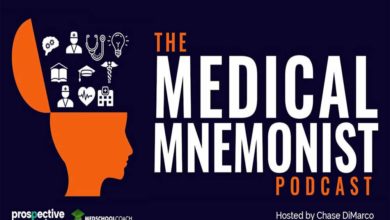In part five of the MedEdge Method mini-series, Chase DiMarco talks about board exam success. He dissects the test-taking technique table and breaks down several test answering strategies such as the tie-breaker technique, the post-exam autopsy, and the error monitoring chart.
- [04:35] Test-Taking Technique Table
- [04:47] Basic Technique
- [07:17] The Tie-Breaker Technique
- [09:50] Post-Exam Autopsy
- [11:22] The Error Monitoring Chart
Test-Taking Technique Table
Before diving into the test-taking strategies discussed in this podcast, we recommend downloading the test-taking table and listening to previous episodes on the Med Edge series, if you haven’t already. The chats are supposed to help you visualize potential mistakes during board exams and also during in-class studies. Remember, the more you practice, the more you strengthen your test-taking abilities.
The test-taking technique table has three columns: Basic Technique, Tie Breaker Technique, and Post-Exam Autopsy.
Basic Technique
The basic technique is a beneficial seven-step process for improving performance on all types of tests. If you already know the answer to a specific question, then you’re practically done with step one. So, answer it and move on to the next question. However, if you are having trouble answering the said question, the following steps will help you settle on the answer more likely to be correct.
- Step 2: Strike Out the Obvious False Answers. Although most students know how crucial it is to strike out the obvious false answers, many students often skip this vital step. The number one reason being that it’s time-consuming. But as mentioned earlier, the more you practice implementing these techniques, the faster you execute this step. So, once you receive your question paper, strike out the obvious false answers and concentrate on the less obvious solutions.
- Step 3: Highlight the Key Features. Vignettes are often full of misleading information aimed at forcing you off track. But, the one way you can improve your odds of picking the correct answer is to highlight the key features.
- Step 4: Rank the Answers Based on the Key Features.
- Step 5: Explore for Partial False Answers. Once you rank the remaining answers based on key features, explore for potential false answers. There will be answers that contain slightly misleading information; hence, your job is to get rid of them and highlight the less obvious options.
- Step 6: Reread the Last Sentence in the Vignette. The last sentence in the question is going to be the actual question that you need to answer. Sometimes the vignettes can be very complicated and throw you off from the fundamental answer question. Therefore, you need to reread the last sentence to remind yourself of what the question is about.
The Tie-Breaker Technique
If you’re still unable to settle on one answer after the six steps, step seven is called the tie-breaker technique.
- Step 1 and 2: Reread the entire vignette and make a pros versus cons list. If you are doing your practice test with no time limit, you can write down a pros and cons list. But if you’re in the middle of an exam, it would be best if you made a mental note of the list. Doing this will make you aware of the reasons for choosing a particular answer.
- Step 3: Reprime answers and interrogatories. This step involves rereading the actual answer questions and options and ensuring you didn’t get lost in the cognitive clutter present in all the other steps.
- Step 4: If, after all those steps, you still can’t settle on a definitive answer, we see no point in wasting any more time on one question. So, just choose one answer and move on to the next question.
Post Exam Autopsy
The post-exam autopsy step is all about going through all the answers chosen and justifying why the answers are correct. If you got an answer wrong, the first step is usually to figure out the right answer. Secondly, ask yourself the mental process behind your choice. Analyze why you chose the said answer and what was the reasoning behind that answer. The last step is all about improvement. What’s the one thing you can do to make sure you don’t repeat the same mistake in future test scenarios?
The Error Monitoring Chart
After the exam, sometimes it isn’t easy to organize errors sensibly. The good news is that the error monitoring chart makes it easier to highlight errors and present them in a language that makes sense. That said, the error monitoring chart consists of three tables: negligence errors, test-procedure errors, and knowledge errors.
- Negligence Errors. These are easy mistakes that you probably should not have made. They range from misreading questions to impulse answering of questions.
- Test Procedure Errors. These errors arise from decisions and actions during the test and are further divided into the sub-categories: stamina and time management, double-check, and tie-breaker errors.
- Knowledge Errors. Knowledge errors arise from knowledge gaps and application mistakes. This means that the main reason why you got the question wrong was that you didn’t have the required knowledge depth to answer the question correctly.
Homework
Go over the downloadable pdf one more time to familiarize yourself with the steps. Take a short quiz and practice the motions as you try to answer the questions in the quiz.
Download the Free MedEdge Method Workbook to access the test-taking technique table
For more study tips, grab a copy of Read This Before Medical School. Don’t forget to leave a rating! Share your experiences, tips, and suggestions to [email protected]. Or you can directly reach out to Chase on LinkedIn, Twitter, or Instagram. Join the Medical Mnemonist Master Mind Facebook group and find our Blog posts, Podcasts, and other Resources at FreeMedEd.org!
